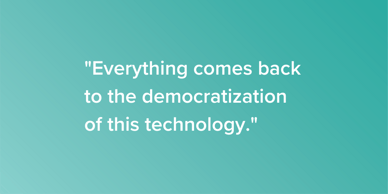It certainly is an exciting time for entertainment. The winds of change are bringing vast technological advancements into play, helping creators tell stories in new and sometimes revolutionary ways. But how exactly will this growth affect an experience? And how does technology intertwine with creative storytelling? This November, Cast & Crew attended Infinity Festival Hollywood to dissect that very issue, joining several panels and learning from industry thought leaders, artists, and experts, all of whom interact with innovative technologies every day.
Innovations in storytelling technology are certainly not a new phenomenon. During her opening presentation at Infinity Festival Hollywood, titled “Story Enabled by Technology - From Infinity and Beyond,” Barbara Marshall of Z by HP Workstations used the paintbrush as an example, reminding the audience of the simple tool’s evolution, adding, “From the beginning of time, artists have always been on the cutting edge, finding new ways to express thoughts and feelings through stories.” In this spirit, creators and artists are looking at complex computer graphics and recent technologies to create as they once did the various iterations of the primitive paintbrush.
.png?width=388&name=Blog%20Templates%20(2).png)
In modern times, creative technological advancement has been driven by the media and entertainment industries, which have created the demand for computational performance with the rise of computer-generated imagery (CGI) and advanced animation. Most recently, the interest in more immersive experiences has led to the utilization of technologies like Augmented Reality (AR) and Virtual Reality (VR), which are redefining what it means to be present in the entertainment experience. This tech gives consumers the ability to self-reflect while simultaneously being entertained. Demand for such innovations is certainly there; these markets are growing exponentially. VR is anticipated to reach $20.9 billion by 2025 (CAGR of 27.9%) and AR spending will grow 18-fold, or from $2.7 billion in 2021 to $48.6 billion in 2025. And most companies in this space are crafting themselves as tentpoles in the community with the creation of branded technology—think Google’s Daydream VR Headset or the Facebook (now Meta) Oculus, which is evolving even further with the introduction of haptic gloves.
Arguably, the fate of this expanding technology sector lies in the hands of storytellers. As was discussed in Final Draft’s panel, "From Concept to Distribution: How Immersive Content Is Changing the Entertainment Industry,” if the stories being told in a new medium are not engaging and calling for consumer attention, then the medium will not make an impact.One place where this kind of storytelling is being tested, the streaming market, is rapidly growing more competitive. As viewers continue to bypass traditional distribution methods, streaming markets are becoming saturated with OTT (over-the-top) options, making original content a highly sought-after commodity. Netflix has made notable investments in original content since producing their first show in 2012. And their 2019 numbers show 37 original series on retainer. Since a subscription business model makes it hard to aggregate a meaningful audience, content must be good to create a consistent consumer base. Original content is a top factor in OTT churn rate, which rose in the U.S. from 35% in Q1 2019 to 41% in Q1 2020.
When attempting to navigate this treacherous content-first environment, adoption is key. As Rick Champagne of NVIDIA taught us, technology is an enabling tool at its core, the term itself derived from the Greek words “techne” and “logos,” meaning art or skill. -1.png?width=388&name=Blog%20Templates%20(1)-1.png) To achieve its purpose, tech must be used by creators to guide consumers and display their creations. Like some sort of digital superpower, tech like Extended Reality (XR) can help improve efficiencies within the creative process, making the impossible into something achievable and accessible. With modern cloud tools and the omniverse, creators will no longer be limited to location, and can work from anywhere, collaborating and seeing changes in real-time. According to forecasts, 600 million (or 30% of all) employees worldwide will be remote by 2024. With the short film Cocreated, HP highlighted the potential for breakthrough remote collaboration, bringing together seven artists from around the world and teasing the new stories we could tell by embracing multiple perspectives.
To achieve its purpose, tech must be used by creators to guide consumers and display their creations. Like some sort of digital superpower, tech like Extended Reality (XR) can help improve efficiencies within the creative process, making the impossible into something achievable and accessible. With modern cloud tools and the omniverse, creators will no longer be limited to location, and can work from anywhere, collaborating and seeing changes in real-time. According to forecasts, 600 million (or 30% of all) employees worldwide will be remote by 2024. With the short film Cocreated, HP highlighted the potential for breakthrough remote collaboration, bringing together seven artists from around the world and teasing the new stories we could tell by embracing multiple perspectives.
So, what does the future hold for creators? Will these innovative technologies become accessible and commonplace? The pandemic-era growth numbers don’t lie—there is a growing openness to  these new technological advances. On the “Story Enabled by Technology” panel, Marc Whitten of Unity summed it up best: “The natural world is incredible, and even just simulating that, there is much more we can do … but even beyond that, what is in our heads—our imaginations—is far richer than that. We are not ready to put down gauntlet—to say that there is not more to be done.” Everything comes back to the democratization of this technology. With remote work, the cat is out of the bag; people know they can create from anywhere. But for the benefits of innovative creation to be felt, these high-end visualization tools need to be adopted by a more diverse group of people. Evolving technology is forcing everyone to rethink what is possible in storytelling, but to reach its full potential, these new tools and methods must be available to a diverse pool of talent.
these new technological advances. On the “Story Enabled by Technology” panel, Marc Whitten of Unity summed it up best: “The natural world is incredible, and even just simulating that, there is much more we can do … but even beyond that, what is in our heads—our imaginations—is far richer than that. We are not ready to put down gauntlet—to say that there is not more to be done.” Everything comes back to the democratization of this technology. With remote work, the cat is out of the bag; people know they can create from anywhere. But for the benefits of innovative creation to be felt, these high-end visualization tools need to be adopted by a more diverse group of people. Evolving technology is forcing everyone to rethink what is possible in storytelling, but to reach its full potential, these new tools and methods must be available to a diverse pool of talent.

